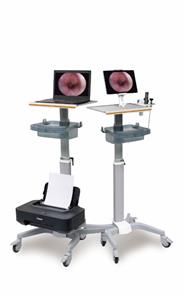Cholangioscopy
Author: Mohammad Wehbi, MD
Background
Cholangioscopy is a noninvasive endoscopic method used for both direct visual diagnostic evaluation and simultaneous therapeutic intervention of the bile ducts. Peroral cholangioscopy overcomes some of the limitations of endoscopic retrograde cholangiopancreatography. (ERCP). Pancreatoscopy is the direct visual evaluation of the pancreatic ducts.
Although cholangioscopy has been in limited use since the 1950s, it has only comapratively recently matured as a noninvasive technique. In the 1970s, Rosch et al and Urakami independently described two different endoscopic methods for peroral cholangioscopy. Since that time, peroral cholangioscopy has been refined largely due to advances in endoscopic technique, scope design, and functionality. However, widespread adoption of peroral cholangioscopy was hampered by technologic hurdles until relatively recently.
Early cholangioscopes had several limitations: they were very fragile and could break up; required two endoscopists; had only a two-way steering mechanism, which severely limited negotiation of ducts; and lacked working channels and irrigation ports. Thus, in the absence of more modern endoscopic technologies, this procedure was restricted to a few specialized centers worldwide for very specific indications. However, the Spyglass cholangioscopes have overcome many of the limitations posed by these earlier cholangioscopes.
With the introduction of a sophisticated spyglass cholangioscope system for cholangiopancreatoscopy, most experts believe that peroral cholangioscopy will soon become a universally adopted technique for the evaluation and treatment of biliary tract diseases. Indeed, the Spyglass cholangiopancreatoscopy showed promising results in a multicenter international study and was approved by the US Food and Drug Administration for diagnostic and therapeutic applications during endoscopic procedures in the pancreaticobiliary system.
Cholangioscopy has been shown to be an effective diagnostic and therapeutic tool. Studies have evaluated clinical efficacy of peroral cholangioscopy in characterizing benign versus malignant natures of biliary strictures, diagnosing intraductal tumors, better defining unknown biliary pathologies, and treating biliary stones.
Direct cholangioscopy (DC) using ultraslim gastroscopes was developed as an alternative to mother-and-baby cholangioscopes. DC provides superior imaging, achieves shorter total procedure time, and has a wider working channel for adequate tissue sampling.
In addition, Itoi et al tested a novel multibending prototype peroral direct cholangioscope (PDCS). This study showed that a cholangioscope passed over a guide wire or anchoring balloon had a high diagnostic and therapeutic success rate. However, results were not appealing with the free-hand insertion technique.
Pohl et al showed that a short-access mother baby scope (SAMBA) is better than DC with regard to intraductal stability and accessibility of the intrahepatic bile ducts. Mori et al suggested duodenal balloon-assisted cholangioscopy as an alternative technique in cases of failure with conventional endoscopic retrograde cholangiopancreatography (ERCP). A digital version of a spyglass cholangioscope is currently being developed.
Image enhancement of endoscopically visualized tissue can be performed by dye, autofluorescence, narrowband image, or probe-based confocal fluorescence (PCLE) microscopy. Cholangioscopy, with the addition of these enhancing methods, helps to distinguish benign from malignant biliary strictures. PCLE provides microscopic information in real time, incorporating dynamic information such as blood flow, cellular architecture, contrast uptake, and leakage. Initial observational studies reported a good sensitivity and negative predictive value of the PCLE findings in diagnosing malignancy. However, evaluation in prospective, randomized studies is needed.
Diagnostic applications are as follows:
- Virtual or optic chromoscopy
- Confocal laser endomicroscopy
- Precise mapping and delineation of intraductal tumor spread before resection
Therapeutic applications are as follows:
- Endoscopic tumor ablation therapy
- Migrating stent removal
- Endoscopic biliary drainage
- Endoscopic nasobiliary drainage
- Plastic stent placement
- Endoscopic resection
- Hot biopsy
- Snare resection
Itoi et al evaluated the efficacy of cholangioscopy in IgG4-related sclerosing cholangitis (IgG4 SC). Their results suggested that cholangioscopy was effective in differentiating IgG4-SC from primary sclerosing cholangitis. Proliferative vessels on cholangioscopy was suggested to be useful to differentiating IgG4-SC from cholangiocarcinoma. Moreover, Suyigama et al showed peroral cholangioscopy to be useful as a preoperative examination modality for assessing tumor extension in cholangiocarcinoma patients.




